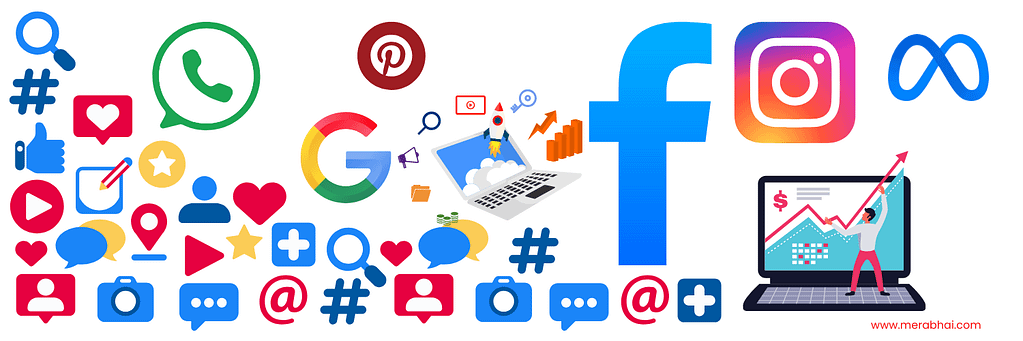Introduction
- Search Engine Optimization (SEO): Optimizing your website to rank higher on Google and other search engines.
- Search Engine Marketing (SEM): Paid ads on search engines (e.g., Google Ads).
- Social Media Marketing (SMM): Marketing via platforms like Facebook, Instagram, LinkedIn, Twitter, and YouTube.
- Content Marketing: Creating valuable content (blogs, videos, guides) to attract and engage your target audience.
- Email Marketing: Sending newsletters and promotional messages directly to customers.
- Affiliate Marketing: Working with affiliates who promote your products and earn a commission.
- Influencer Marketing: Collaborating with social media influencers to promote your brand.
- Mobile Marketing: Promotions via SMS, WhatsApp, and mobile apps.
In a world where every brand is battling for attention, digital marketing has emerged as the single most powerful way to connect businesses with their audience. Whether you’re running a boutique clothing store in Delhi, a homegrown food brand in Bengaluru, or a coaching center in Patna, digital marketing can transform your business visibility, reach, and revenue.
In this beginner-friendly guide, we break down what digital marketing is, why it matters for Indian businesses, and how you can get started step by step.
Chapter 1: Understanding Digital Marketing
Digital marketing refers to any form of marketing that uses electronic devices or the internet. It’s the art and science of promoting your business online through channels like search engines, websites, social media, emails, and mobile apps.
Key Digital Marketing Channels:
Chapter 2: Why Digital Marketing Matters for Indian Businesses
India is home to over 850 million internet users in 2025. More than 75% of consumers research online before buying anything, even offline.
Benefits for Indian businesses:
- Cost-effective: Compared to TV or newspaper ads, digital marketing offers higher ROI.
- Targeted reach: You can target users by city, age, gender, interests, and more.
- Real-time analytics: Know exactly what’s working and what’s not.
- 24/7 presence: Your business can be discovered anytime, anywhere.
- Scalability: Start with a small budget and scale as results come in.
Industries benefiting the most in India:
- Retail & E-commerce
- Education (EdTech, coaching)
- Food & Beverages
- Healthcare
- Real Estate
- Local Services (salons, home repair, etc.)
Chapter 3: Core Components of a Digital Marketing Strategy
- Goal Setting: Define what success means to you – more leads, higher sales, brand awareness?
- Target Audience: Identify who your customers are. Use personas and data.
- Online Presence: Have a professional website and active social media profiles.
- SEO & Content: Rank on Google for keywords people search.
- Social Media & Ads: Reach wider audiences with organic content and paid campaigns.
- Email & WhatsApp: Retain existing customers with updates, deals, and reminders.
- Analytics: Use tools like Google Analytics, Meta Insights, and HubSpot to track performance.
Chapter 4: Digital Marketing in Action – Examples
- Local Restaurant in Jaipur: Uses Instagram Reels + Google My Business to attract tourists.
- Tuition Center in Lucknow: Runs WhatsApp campaigns and YouTube content to gain student registrations.
- Fashion Brand in Surat: Uses Instagram + influencer collaborations + SEO to drive traffic to their online store.
- Home Cleaning Service in Mumbai: Google Ads + customer reviews + local SEO bring in steady inquiries.
Chapter 5: Free & Paid Tools You Can Use

Free Tools:
- Google Business Profile (for local SEO)
- Canva (design)
- Mailchimp (basic email marketing)
- Google Analytics (website traffic tracking)
- Ubersuggest (keyword research)
Paid Tools:
- Meta Ads Manager (Facebook/Instagram Ads)
- Google Ads
- SEMrush or Ahrefs (SEO)
- Zoho Campaigns / HubSpot (CRM & Email)
- Buffer / Hootsuite (social media scheduling)
Chapter 6: Common Mistakes to Avoid
- Ignoring SEO
- Buying fake followers or engagement
- Not optimizing for mobile users
- Posting inconsistently on social media
- Lacking clear Call-To-Actions (CTAs)
- Not using analytics to track and adapt
Chapter 7: How to Get Started Today
- Claim your Google Business Profile
- Create a simple website or landing page
- Start with one platform (e.g., Instagram) and post regularly
- Run a basic Facebook or Google Ad with a ₹500 budget
- Collect emails or WhatsApp numbers for remarketing
- Analyze performance weekly and make improvements
Chapter 8: Should You Hire a Digital Marketing Agency?
Hiring an agency can:
- Save time and avoid costly mistakes
- Give access to expert talent
- Bring professional design, content, and ad skills
- Help you scale faster with data-driven decisions
If you’re too busy running your business or want faster growth, partnering with a digital agency can be a game-changer.
Conclusion: The Future is Digital
Digital marketing is no longer optional. It’s the backbone of every modern business. Whether you’re a solopreneur, SME, or growing brand, embracing digital marketing can help you stand out, attract customers, and grow consistently.
Start small, stay consistent, and don’t be afraid to experiment. And if you ever feel stuck, there’s always a professional digital marketing agency ready to help you scale.
Call-To-Action
Ready to take your business online or scale your digital presence? Contact MeraBhai – Digital Marketing today for a free consultation.
Let’s grow together!

Pingback: How to Plan a Digital Marketing Budget That Actually Works (2025 Edition) - MeraBhai Digital Marketing Agency
Pingback: How to Choose the Best Digital Marketing Agency in 2025 - MeraBhai Digital Marketing Agency
Pingback: Best Digital Marketing Strategies for Business Growth This Year - MeraBhai Digital Marketing Agency
Pingback: Perplexity AI: Find Hidden Content Opportunities in Indian Verticals - MeraBhai Digital Marketing Agency